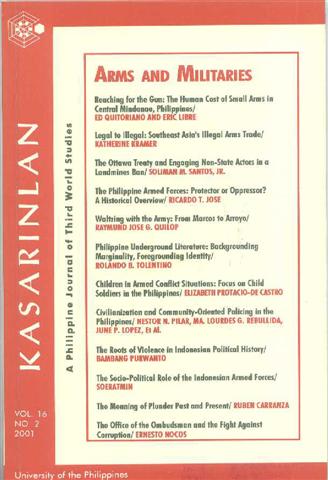Children in Armed Conflict Situations: Focus on Child Soldiers in the Philippines
Abstract
n the last 30 years of internal armed conflict in the Philippines, children have become both victim and perpetrator of violence. Children, boys and girls not even eighteen years of age, bear arms for the New People's Army (NPA), the Moro National Uberation Front (MNLF), the Moro Islamic Liberation Front (MILF) and the Abu Sayyaf. Children old enough tQ cany and use M-16 and AK-47 rifles are volunteered, coerced and even manipulated into armed groups. Young and impressionable, child soldiers can become the fiercest fighters through indoctrination. According to the author, there are several reasons why children end up fighting alongside adults. These children may have been victims of physical or sexual abuse or witnesses to the death of a loved one in the hands of government forces. Some factors are more complex. There may be experiences of neglect and abuse, weak family ties and negative experiences in school, or a combination of all the above.Poverty, social injustice, and limited or no access to basic services are contributing factors to the creation of the child soldier. Being exposed to armed conflict situations, children are exposed not only to grave I and serious physical danger but also to psychological trauma resulting from capture, torture and rape, and detention. Having experiences also result in child soldiers living with shame and guilt and reacting with apathy and numbness for the rest of their lives. They are faced with extremely polarized moral dilemmas such as self-preservation
and killing another human being for the glory of God, freedom and the oppressed people. Should they be taken out of armed conflict situations, child soldiers find difficulty in re-joining their communities or having normal lives. Often they return to their comrades in the battlefields.
How to Cite
DE CASTRO, Elizabeth Protacio.
Children in Armed Conflict Situations: Focus on Child Soldiers in the Philippines.
Kasarinlan: Philippine Journal of Third World Studies, [S.l.], v. 16, n. 2, sep. 2007.
ISSN 2012-080X.
Available at: <https://journals.upd.edu.ph/index.php/kasarinlan/article/view/1649>. Date accessed: 11 sep. 2025.
Section
Research Reports
By submitting a manuscript, the authors agree that the exclusive rights to reproduce and distribute the article have been given to the Third World Studies Center.



